


 |
 |
 |
| HomeAbout Billiards DigestContact UsArchiveAll About PoolEquipmentOur AdvertisersLinks |
|
Browse Features
Tips & InstructionAsk Jeanette Lee Blogs/Columns Stroke of Genius 30 Over 30 Untold Stories Pool on TV Event Calendar Power Index |
Current Issue
Going to Great Lengths What started as an experiment by one of the game's all-time greats has become commonplace with many pros and amateurs incorporating cue extensions whether they need to stretch or not. By Nicholas Leider WhenPlenty of self-help books and social media influencers have recommended doing things that make you uncomfortable, stepping outside your comfort zone, or putting yourself in new situations. As catalysts for personal improvement, these suggestions can veer too far into cliché to be effective. But that doesn't mean improvement can't be found in unexpected places. For pool players, innovation can be an elusive concept. The industry is constantly improving the materials and methods in producing equipment — the carbon-shaft revolution is testament to that. But for personal improvement at the table, many discoveries are limited to between a player's ears by drilling fundamentals, refining shot selection and pattern play, and building mental strength and confidence through practice and competition. But one recent development shows that inspiration can strike in unlikely places. By the end of the aughts, some pool purists decided to resurrect the 10-foot table to present a new challenge to players who were as close as any to “solving” rotation games on the traditional 9-foot table. Maybe a gimmick at the start, the table showed up at the Derby City Classic, where people could see how pros handled the extra real estate. In 2013, Derby City officially included the Big Foot Challenge, a tournament on the larger playing surface. During this time, Earl Strickland was tinkering around with his equipment, which has been a near-constant in his four-plus decades as a professional. He had weights on his arms, a wrap around his midsection, tried different wraps on his cue, finger extensions and used various gloves to improve his grip and feel. But when he started practicing on the 10-foot table, he noticed one tweak that paid immediate dividends. 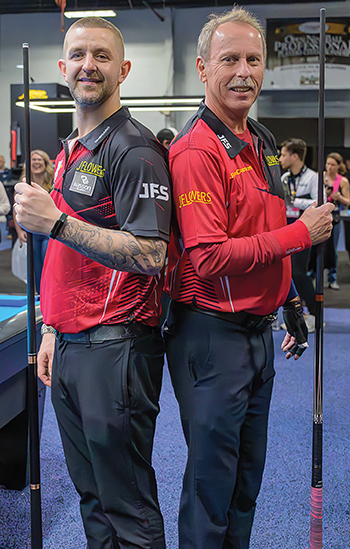 Jasyon Shaw (left) and Earl Strickland (right) are two of the game's biggest proponent of longer playing cues. (photo by Erwin Dionisio) “It was maybe a dozen years ago? I started playing on a 5-by-10,” he said. “That's how I discovered the cue needed to be longer. Had I never exposed myself to the larger table, I never would've discovered [that I needed a longer cue].” Playing full-time with an extension screwed into the butt of his cue, Strickland felt more at home than he had in years. “Once I went to the long cue, I couldn't go back,” he said. “There's no going back if you're tall enough —, you have to be a certain height to play with a real long one. Even if you're shorter — 5'9” or 5'10” — and you put a little extension on, once you play with it, you can't go back.” Exactly why a few extra inches led to such a lightbulb going off for Strickland, it came down to the benefits greatly outweighing the drawbacks — literally. “[The extension] deprives your draw a little, just a little bit, but it helps for a lot of other shots,” he said. “When you're rolling the ball against a rail, when the cue ball needs a little more velocity —, there are hundreds of shots where it helps, but it hurts the draw a little.” 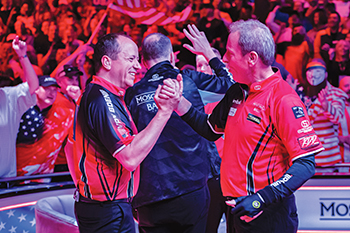 For Van Boening (left), hero Strickland's (right) decision to play long was all he needed to hear. A true believer, Strickland tried to spread the gospel of an extended cue. And while plenty of players, pros and amateurs alike, looked at the gloves and wrist weights with healthy doses of skepticism (bordering on ridicule), he gained followers when it came to longer cues. One of his first and still most prominent converts is Shane Van Boening. The two American legends matched up on a 10-foot table for a race-to-21 in 2013, right when Van Boening was head and shoulders above any other American. Strickland, in the uncommon position as underdog, rode his extended cue to a surprise 21-20 victory — a moment that stuck with Van Boening. “I started using an extension on all shots about seven years ago,” he said. “I followed Earl's path — he's always been my hero and I figured he knew what he was doing.” The Business End Cuemakers and pool equipment companies have been familiar with extensions for years. When they started to become more common place around the turn of the century, many designs were focused solely on eliminating the need to use the bridge. Some extensions were clunky plastic tubes with material inside to fit snugly on the butt of the cue. More refined designs started to appear, with cuemakers adjusting their bumpers to allow for extensions to screw directly into the cue butt. With extensions being incorporated into regular playing cues, suppliers are focused on meeting the demands of consumers in a growing niche. “Over the past few years, I would say we sold extensions in one of four cues [in 2021],” said Brett Garson, brand manager with Cuetec. “Now it's where it's almost one to one.”  Sanchez Ruiz added an extension for all shots in 2020, and hasn't missed a beat. As demand for extensions grew, cuemakers responded by changing designs to allow for more customization. “Four or five years ago, we changed our bumper system so they all could accept an extension if you wanted to,” said Brandon Jacoby of Jacoby Custom Cues. “You're starting to see that trend where cues are coming with that feature because it is so common.” He also noted that joint extensions are also available, which are inserted between the shaft and the butt, rather than the standard butt extension on the back of the cue. “We are seeing a lot of people play with extensions,” he said. “If you're looking to extend to reach a shot, do it in the back end of the cue. But when you add length at the joint, it adds the least amount of weight because its smaller in diameter. As long as it's made from good materials, [an extension] really shouldn't change the playability of the cue. At the end of the day, you want to lengthen the cue, not alter it.” With an extension on the butt of a cue, that added weight can change the balance. To that end, cuemakers are trying to introduce lighter products that reduce impact on a cue's overall feel. 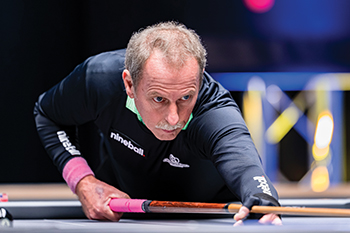 Strickland, notorious for quirky playing aids, hit the mark with his extended cue. “We started with a heavy 4.5-ounce extension that was just a solid piece of wood,” Garson said. “Now, we're using a composite that's a little lighter than carbon. And we offer a dual extension that comes with a three-inch piece and six-inch piece that can be combined to get nine inches.” This flexibility, while reducing the amount of gear a player has to lug around, is key to meeting players' needs when it comes to customizing a cue. Professional Preferences For top players, though, it can boil down to something as nebulous as feel. Van Boening currently uses a six-inch extension that allows him to add more length to avoid using a bridge. For him, an extended cue was only logical to fit a frame that is bigger than most professionals. “I'm taller than most players to start with, so it came easy to me,” he said. “I never worry about it affecting the balance of the cue — I have longer arms, so it was easy to adapt.” Francisco Sanchez Ruiz, another world-beater who's on the lanky side, also found comfort adding a bit of length to his playing cue. “I just tried it three or four years ago,” he said. “I put a small extension [on my playing cue] and I started feeling better. Now that I've found one that's perfect for me, I like the weight and the balance of the cue. I don't want to change.” His countryman and Mosconi Cup teammate David Alcaide, however, proves that longer is not better for every top player. “Years ago, I used an extension, but it was so heavy — I felt like something was off. It might be better for longer shots, but I like to focus on cue ball control. When I put the extension on, I don't feel like I have the control I want on soft shots. I don't have the confidence [I need]. Besides Strickland and Van Boening, Jayson Shaw may be the most visible proponent of the everyday use of extensions. And like Van Boening, he was won over by a little lobbying by Strickland. “Earl was telling me it would be good for me,” he said. “And I went to Derby one year to play on the 10-footer. I was using the bridge and stretching on every shot, so I started practicing with an extension. Once I had it on, I never took it off.” Shaw now uses a standard 57-inch cue with an eight-inch extension. “It gives you more power,” he said. “You can manipulate the cue ball differently. With longer shots, it seems to stay on the cue ball longer, so you get less throw.” 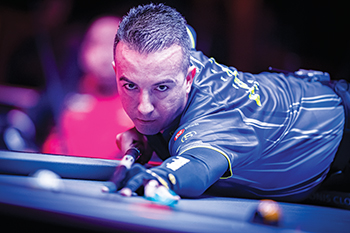 Spain's Alcaide experimented with the longer cue, but felt he lost control. Darren Appleton saw similar results when he incorporated a three-inch extension. “If you're not getting through the cue ball that well, if helps you have a little more power —, that was the big thing for me,” he said. “Like for someone like Jayson, who has a shorter stroke, it helps him get through the cue ball with a little less effort.” Still, Appleton carries extensions in his cue bag, he will go back and forth in the length of his cue. “Right now, I never start a match with an extension on the cue,” he said. “But if I wasn't cueing the ball well or I wasn't feeling good about the stroke, I'll put one on. For me, it was a bit of an excuse — maybe I can put one on and feel better.” Market Mechanics While it's impossible to tell someone what will or won't work for them, it's clear extensions are becoming a normal part of a player's gear. Garson noted that Cuetec's Van Boening-inspired Dakota Edition cues can come with an extension package, with a majority of buyers opting to include it. The more pros like Van Boening, Ruiz and Shaw continue to win world titles with longer cues, the harder it becomes to wave away all this talk as a fad. But it remains to be seen if easily modifying a cue's length will pay dividends to players of all skill levels. “It's a lot like what goes on in golf,” Appleton said. “When I started playing golf, I started with Ping because I'm a fan of Lee Westwood. That's what pool players are doing with Joshua Filler with Predator and Shane with Cuetec — it's good marketing really.” 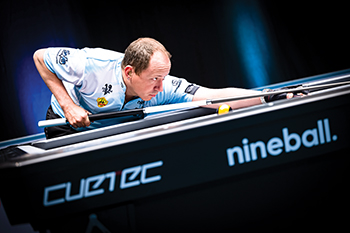 Few can argue with Van Boening's success extending his cue to 63 inches. Alcaide, sticking with his standard-length cue, encourages players to remember all that is important is what's right for them. “I think so many people watch top players use them, so they think it must be better for them,” Alcaide said. “But if it's better for the best players, it might not be the best for everyone. I practice with FSR all the time. He uses an extension and I don't. Why? We are both trying to check what's best for us.” In the end, extensions appeal to players, they offer retailers another product to offer customers, and look to be a part of the game for the foreseeable future — all the result of a detour Strickland took from a 9-foot table to a 10-footer. “It's one of the greatest discoveries in pool in some time,” he said. “It helps everybody. It helps the industry. The only thing is it didn't help me [financially], but I guess you couldn't have patented it anyway.” Style + Function The latest and hottest cues on the market Viking Cue Better cues lead to better games, and there isn't a game better than Fedor Gorst's. The B3391 Fedor Gorst Playing Cue from Viking features a Bacote forearm and butt sleeve, brass, pearl and black rings, the Viking Quick Release joint, Tiger Everest laminated tip and the VIKORE Performance Shaft. MSRP: $530 www.vikingcue.com 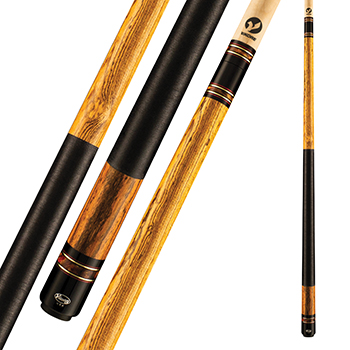 Cue & Case Experience the FUZE Kielwood Carbon InFUZED solid shaft, the ultimate blend of tradition and innovation. Engineered for precision and control, the InFUZED shaft combines proprietary technology with unparalleled performance of Kielwood. MSRP: $425 www.cueandcase.com 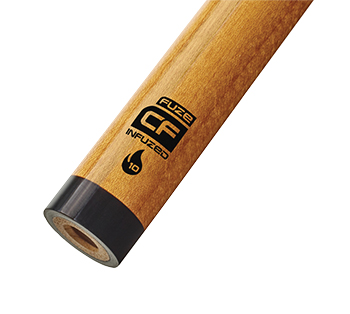 McDermott Cue The G904 showcases the vibrant Hummingbird ShokRes material in its sleeve and points, creating a striking contrast against a black urethane forearm. The G904 is equipped with a sleek black pig leather wrap and a high performance G-Core shaft, ensuring an exceptional playing experience. MSRP: $950 www.mcdermottcue.com 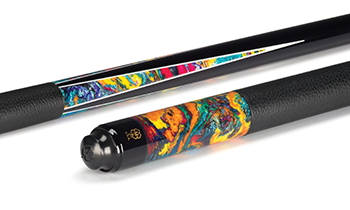 J&J America A Black Arrow carbon fiber shaft and rock maple butt doesn't have to be expensive. The J&J America cues also come with a Kamui or Zan tip and Uni-Loc joint. MSRP: $570 www.jjcue.com  CueStix International Subtle style and consistent performance are yours with the new 25 oz. black shaft Breaker, the latest addition to the Eight Ball Mafia break cue line. It features a 13mm phenolic tip with a transparent hot green acrylic break pad, Inox quick-release pin and the ever-popular sport wrap. MSRP: $199 www.cuestix.com 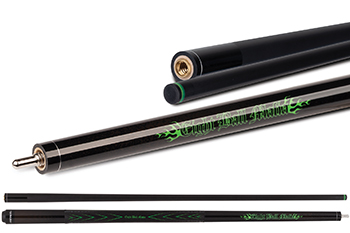 Koda Bull Carbon's six-point line is back with a limited run, featuring 11.75 or 12.25 mm Bull Carbon Technology shafts topped with a Kamui black soft tip. Every shaft comes with the V-Tek interchangeable joint system, making it easy to share the love across multiple cues. MSRP: $1,119 www.playkoda.com 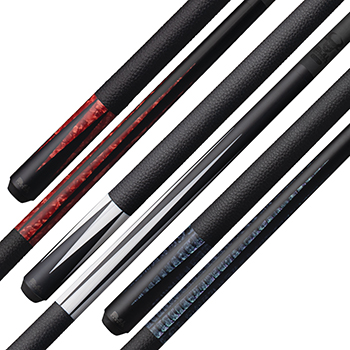 Cuetec The AVID Surge Series delivers a rush of energy, with power to spare. Constructed with multiple layers of glass fibers over maple, Surge Series cues deliver supercharged performance whether you're going through the rack, or over it! MSRP: $239-$399 www.cuetec.com 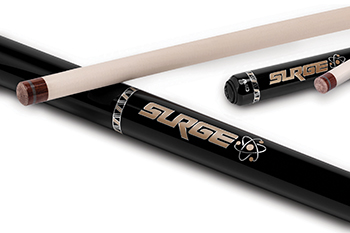 Imperial Make a statement with the solid maple, two-piece Vision Series cues, which come in eight eye-catching colors. Not only does this cue look amazing, but is features a premium seven-layer, 13.1 mm tip for precision on every shot. MSRP: $69.99 www.imperialusa.com 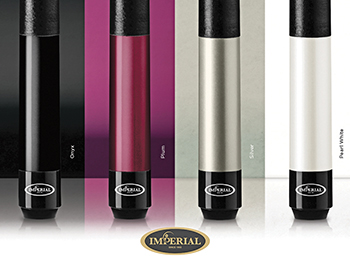 Miki Co., Ltd. Unleash your game-changing potential with the Mezz Airdrive 3, featuring innovative jump cue technology for superior power and precision. Engineered with full carbon construction and a specially designed taper, the Airdrive 3 delivers unmatched performance and versatility. MSRP: $669 www.mezzcue.com  Meucci Cues The BMC Casino 7 Snakewood is strikingly beautiful, with an exotic Snakewood forearm adorned with diamond pattern Paua shell inlays. The butt sleeve features a four-card configuration of your choice and six inlaid dice. MSRP: $1,800 www.meuccicues.com  Koda K2 just launched a new lineup of eye-catching Sneaky Pete cues, available in five color combinations and featuring low-deflection shafts, Everest tips and Uni-Loc joints. MSRP: $274.99 www.playkoda.com 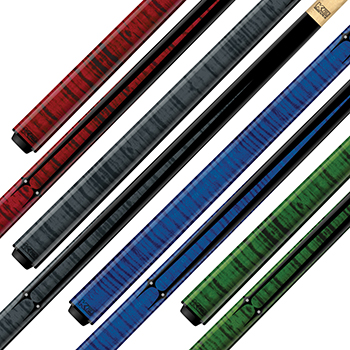 Cue & Case Break and jump like a pro with the PureX carbon fiber break cue. Constructed from premium carbon fiber, the PureX produces unmatched strength and resilience for consistent performance. The Turbo-Lock joint system enables quick and secure assembly for hassle-free setup. MSRP: $449 www.cueandcase.com 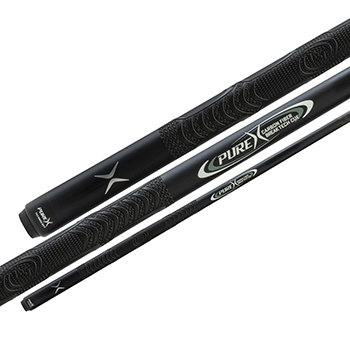 Cuetec Engineered to provide the most effortless and dynamic jumping experience, Cynergy Propel jump cues feature an all-composite construction and weigh in at an ultralight 11 ounces with its weighted extension attached. Propel jump cues not only excel at both full-table and close proximity jumps but provide tremendous accuracy and eliminate unintended side spin. MSRP: $509 www.cuetec.com 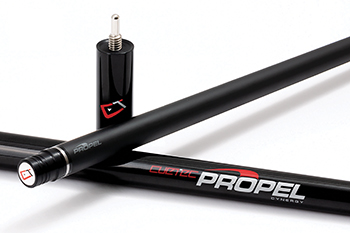 Cuetec Engineered to run rings around the competition, the Cynergy Truewood Series features all new construction utilizing Cuetec's Clear-Tec epoxy resin finish for increased stiffness and reduced vibration. Paired with the world-renowned Cynergy shafts, the all new Truewood Series is Cuetec's most advanced playing cue to date. MSRP: $869-$1,059 www.cuetec.com 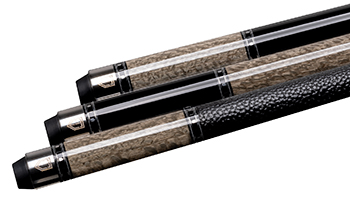 Imperial Stylish and reliable, Chevron Series solid maple cues provide excellent performance and feature seven-layer tips for accuracy and polyurethane dynamic traction wraps for control. MSRP: $109.99 www.imperialusa.com 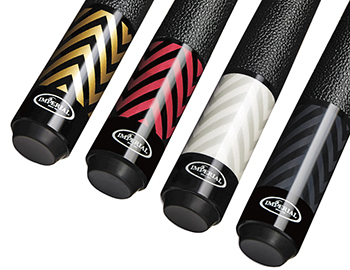 RAM Game Room Eye-popping fluorescent colors make Raid cues stand out. With a professional tapered Canadian maple shaft, low-deflection technology, a quick-release system with matching colorful joint and a matte finish treated forearm and gloss finish handle, the Raid is ready for action. MSRP: $127 www.ramgameroom.com 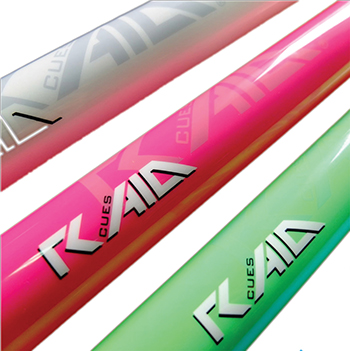 Koda Koda's new 2024 KD lineup has some sizzle, from all new matte finish looks to sleek and sexy, and all featuring 3/8x10 joints for a solid hit and feel. MSRP: $199.99-$219.99 www.playkoda.com 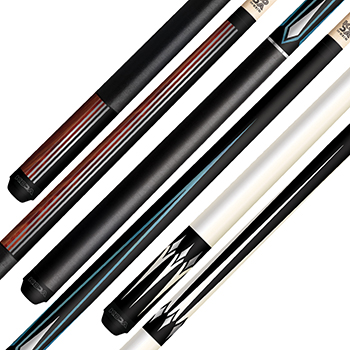 Cue & Case Meticulously crafted for precision and performance, the Lucasi Pro Carbon InFUZED 10S shaft features 10-splice, low-deflection Lucasi Technology infused with state-of-the-art carbon fiber InFUZED technology for accuracy and ball control while preserving an authentic wood feel. MSRP: $475 www.cueandcase.com 
|
|
Since 1978, Billiards Digest magazine has been the pool world’s best source for news, tournament coverage, player profiles, bold editorials, and advice on how to play pool. Our instructors include superstars Nick Varner and Jeanette Lee. Every issue features the pool accessories and equipment you love — pool cues, pool tables, instruction aids and more. Columnists Mike Shamos and R.A. Dyer examine legends like Willie Mosconi and Minnesota Fats, and dig deep into the histories of pool games like 8-ball, 9-ball and straight pool.
Copyright © 1997 - 2025 Billiards Digest
All Rights Reserved
Luby Publishing, Inc.
310 Busse Highway PBM #319 | Park Ridge, IL 60068
Phone: 312-341-1110 | Fax: 312-341-1469